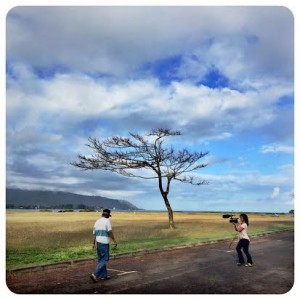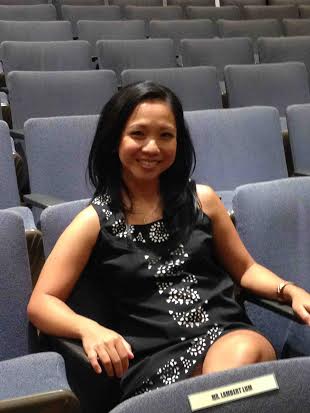
ALYA B. HONASAN
THE SAKADA of Hawaii, pioneering migrants who came to the island from their home provinces in the Philippines to work in the sugar and pineapple fields, have always been pictured as long-suffering. They certainly endured much in helping build what was to be their adopted home, Hawaii.
Succeeding batches of workers did manage to reap the fruits of their labors, however. In “A Sakada Story,” a short film by young Filipino-Hawaiian filmmaker Maribel Apuya, the subject, Cipriano Erice, originally from Narvacan, Ilocos Sur, is now retired, drives a sedan and hangs out at McDonald’s with his buddies.
It was still quite the journey for the old man. In an emotional moment in the film, Erice recounts how he was finally promoted to journeyman, big boss among the workers—and he is on the verge of tears, albeit triumphant ones.
Enough of the Filipino migrant as victim, Apuya declares. “In doing this film, my mission is to showcase the culture in a positive, empowered light. Many have studied and documented the sakada, but my point of view is what they have given us.”
The film debuted at the Philippine Consulate in New York last August 2015 as part of the consulate’s “Sinehan sa Summer” activity, and was later screened at the Ohina Short Film Festival at the Honolulu Museum of Arts and at the Hawaii International Film Festival, Hawaii’s premiere film festival. It is the 36-year-old Apuya’s first film.
Next two films
Based on the positive response to “A Sakada Story,” it won’t be her last. With recently approved funding from the Atherton Family Foundation and the Mayor’s Office of Culture and the Arts in Honolulu, Apuya will be working on her next two short films: “Bayanihan,” which will feature another sakada, Angel Ramos, and “Sakada Dreams,” which will feature Apolonia Stice, a female sakada born and raised in the Spreckelsville camp in Maui, Hawaii—probably the first time a female sakada’s story will be documented on film. Apuya hopes to get the work done by June.
It’s been quite the journey for Apuya, who was born in Quezon City, one of three children; her father is a lawyer and her mother, a medical technologist. The family had just been considering migrating in 1990 when their Novaliches home was broken into. “That propelled my parents to go,” Apuya recalls. “I didn’t want to—I was 12, and I had all these friends in school already.”
The family spent a year in California, where she recalls being “very shy—I felt like I wasn’t good enough. When we moved to Hawaii, I made a conscious decision to stick with the local kids, because I wanted to be more socially accepted.”
Pro-Filipino
Having been exposed to life in both the Philippines and the United States has shaped her perspective, Apuya says. “If I had been born here, maybe I would not have been so pro-Filipino.”
She went on to the University of Hawaii in Manoa, where, as a computer science and political science student—she originally planned to follow in her father’s footsteps—she was a Presidential and a National Science Foundation scholar.
She was, however, also mentored by professors at the Center for Philippine Studies, like Dr. Teresita Ramos and Dr. Ruth Mabanglo. “Being around them shot up my passion for being Filipino, in a truthful way. Art was my elective, and it called to me. Let’s just say I had my midlife crisis early!”
Apuya went on to study acting at the Neighborhood Playhouse School of the Theatre in New York City. She also traveled, worked as a yoga teacher and even had a stint in financial services.
In an interesting sidelight, she studied modelling at 18 and was actually crowned Miss Hawaii Filipina in 2001, an experience she no longer trivializes. “And to think, I used to omit that from my film bio,” she says with a laugh.
Although Apuya’s mother was against it, she still joined the pageant. “I think it’s pretty pivotal to development, when you’re put in a situation where you just have to learn, and you don’t know what you’re capable of until you’re in it. I became even more passionate about Filipino culture—it was organic, fun and warm. And the parties were fun!”
She eventually chose film, “because I get to choose what work gets to be there,” Apuya says. “As an actress you’re at the mercy of directors, who are mainly white—which is fine, although Hollywood has a lot of catching up to do, even with the women.
Write our own stories

“In film I get to say, this is the role, this is the movie. I know the acting perspective, I understand marketing; I’m in a position now where I can write not only art but also something that will speak to a large audience. As Asian Americans, we have to write our own stories. I know I can write these stories, even if Scorsese’s not exactly knocking on my door.”
She’s soldiering on, because “It’s important to express who I really am—I’m Filipino but I’m also American—and I have to express that voice authentically, and in the best way I can. And that will evolve.”
After 10 years of living in New York, Apuya came home to Hawaii to make her film, although she is now still enrolled in a screenwriting course at the University of California at Los Angeles.
It took a few months to get to know her subject, Cipriano Erice, before she could earn his trust and tell his story. After that, it took only 17 days to shoot and edit the 10-minute short film, with help from her supervising producer, Chandler Griffith.
“My grandfather was a plantation laborer, so I knew the story and had read books,” Apuya recalls. “I must have spent three months warming him (Erice) up. Nobody has the patience to do that anymore. Now, after the film, I feel there’s so much more to be said. I need to continue the storytelling and propel the story in a positive way.”
Tough time
Apuya discovered that Filipinos in Hawaii did have a tough time in the ’70s, when they were heavily discriminated against. She admits she still felt some of it, as well, even as a teenager in high school in Waipahu, Oahu, in the ’90s.
“Pinoys really do stick out, in terms of characterization and perception. You can tell immediately. Filipinos tend to keep to themselves and don’t go out into the larger community,” she says.
“In New York, I spent a lot of time in the theater, and a friend once observed that Filipinos had not healed. Healing means finding your voice, a way to express yourself. We have a lot of issues. Colonialism, for example, is a hurt that runs deep. The Philippines has a national inferiority complex! Even my friends wonder why I keep apologizing for things!”
Apuya’s dream project is actually a film based on a Hawaiian myth, the kahuna, a spiritual being, this time embodied in a young girl who wants to be a warrior, and who discovers herself in the process. “Hawaii is my home, so it felt right to write a Hawaii story. I have to honor my culture before I can be blessed, right?”
When she’s not writing three to five hours a day, Apuya surfs, of course. But right now, it’s the stories of her forebears that she’s focusing on.
“It’s like doing PR work for the sakada,” she says with a laugh. “Some people don’t even want to be associated with them because they were uneducated, but there’s a way to tell the story where they’re not victimized. As a filmmaker, you can affect how to tell the story, and there’s a need to brand ourselves differently. We have to change perception, and that’s healthy.”









































